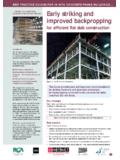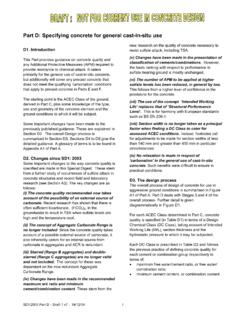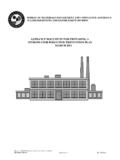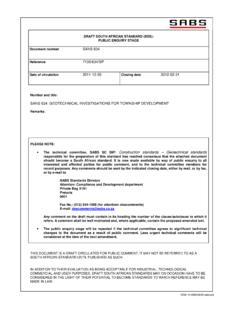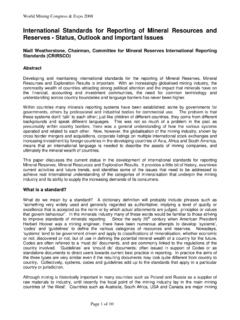Transcription of Part C: Assessing the aggressive chemical …
1 SD1:2005 Part C - Draft 1 v8: 14/12/041 Part C: Assessing the aggressive chemical environmentC1. GeneralThis Part describes the occurrence of chemicals in theground that are potentially harmful to concrete andgives procedures that lead to assessment of theAggressive chemical Environment for Concrete(ACEC) Class of the discussion on the occurrence of aggressivechemicals includes reference to some types in landcontaminated by the activities of man. The scheme forground assessment is, however, restricted to naturalground, ground mildly contaminated by some commonmanmade chemicals and fills derived from both ofthese.
2 Ground containing excessive amounts ofmanmade chemicals (for example resulting in anacidity of less than pH ) or rarely encounteredsubstances are not catered for by the ACEC classification and will require specialist investigationand assessment. The various stages in the ground assessment anddecisions affecting concrete are set out in Figure A1 ofPart A. The detailed steps involved in groundassessment are shown in Figure C1. The terminologyused in the various boxes of these figures is explainedlater. BRE Digests prior to SD1:2001 used a primaryclassification of ground into five sulfate classes.
3 Theyalso gave incremental rules for modification of theseprimary classes to account for other factors that affectthe severity of chemical attack, including: groundwater acidity and mobility concrete geometry, curing conditions and type , however, these recommendedmodifications were overlooked or incorrectly applied bydesigners and new approach to classification of aggressive groundconditions was therefore adopted in SD1:2000 that iscontinued with slight modification here. The derivedACEC class takes direct account of the type of site, thesulfate concentration, and the groundwater acidity which are specific to the concrete construction,such as type of element, section thickness, curingconditions, application of hydrostatic pressure and theintended working life, are taken account of separately inParts D to F when specifying concrete quality to meet theassessed ground site assessment procedures are given here fornatural ground, for brownfield locations that may containaggressive chemical residues.
4 And pyritic ground. Theprocedure for the latter is specifically included owing torecently found severe TSA in highway sub-structuresembedded in pyrite-bearing Lower Lias Clay fill:generation of sulfate due to oxidation of the pyritefollowing ground disturbance was found to be a key changes have been made to the procedure forground assessment as compared with the previous editionof SD1: The limits of the Design Sulfate Classes based on 2:1water/soil extract tests on soil have been reduced,making this classification route more conservative(see Box C7).
5 There is no need to take high magnesium levels intoaccount for natural ground the m suffix DesignSulfate Classes now only apply to brownfieldlocations. This is because, in the UK natural groundconditions, magnesium levels are invariably wellbelow values which may significantly affect concrete. The concentrations of sulfate, magnesium and otherrelevant chemicals in water and water/soil extracts areexpressed in mg/l instead of g/l. Minor changes include re-naming the former Highly Mobilegroundwater as Flowing water and catering for presenceof this in the aggressive chemical Environment forConcrete classification (Table C1) for some types :2005 Part C - Draft 1 v8: 14/12/042 Steps of procedure 1.
6 Carry out Desk Study and Walk Over of site to identify type of site, eg Brownfield, and any ground conditions which may be aggressive to concrete Refer to Special Digest Sections and 2. Carry out Ground Investigation to determine: a) Groundwater mobility (Static, Mobile, Flowing) b) Concentrations of aggressive chemicals in soil and groundwater, including: - sulfates - sulfides (especially in pyritic ground) - water soluble magnesium - acids (indicators pH, chloride and nitrate ions) Section and C3 Section 3.
7 Determine Design Sulfate Class for site or site locations Step 3 of Sections , and 4. Determine aggressive chemical Environment for Concrete (ACEC) Class for the site or site locations from Table C1or C2, taking into account: - Design Sulfate Class, - type of site (Natural ground or Brownfield) - water mobility - pHSection and Tables C1 and C2 8.
8 Proceed to concrete specification in Parts D, E and F of Special Digest Continue as Stage 3 of Figure A1. 20-11-04 Figure C1: Procedure for Assessing ground environments that are aggressive to concrete. SD1:2005 Part C - Draft 1 v8: 14/12/043C2. Principal constituents of aggressiveground and groundwaterThis Section describes the chemical agents commonlyencountered in natural ground and brownfield locationsthat are aggressive to concrete. It does not discussother types of chemical activity or Sulfates and sulfidesSulfates commonly occur both in the solid part of theground (soil, rock or fill) and in groundwater.
9 Sulfatescan also be derived by oxidation of sulfides, such aspyrite (FeS2), by natural processes such as weathering,sometimes aided by construction activities. It is,therefore, necessary to consider the distribution ofsulfides, as well as sulfates in ground, which may beaffect buried concrete. It should be noted, however,that sulfides usually provide no hazard to concrete inthe absence of oxygen and mobile water. Box C1 liststhe main sulfur species found in the UK, most of whichare either sulfates or overview of the role and occurrence of sulfates andsulfides is given here.
10 A more detailed discussion isgiven in Chapter 3 of the Thaumasite Expert GroupReport [1]. Natural groundIn UK natural ground, sulfates most commonly occur inthe form of hydrated calcium sulfate (gypsum).Significant amounts of magnesium sulfate (epsomite)and sodium sulfate (Glauber s salt) may also sulfate has limited solubility, producing amaximum concentration of SO4 in water at normalground temperatures of about 1400 mg/l. Magnesiumsulfate and sodium sulfate are much more soluble so, ifpresent in the ground in sufficient quantities, willdissolve to produce sulfate concentrations many timesgreater.
